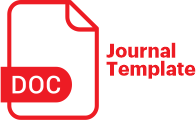Pemodelan Persamaan Navier-Stokes untuk Aliran Fluida Tidak Termampatkan
DOI:
https://doi.org/10.26555/konvergensi.v6i1.19545Keywords:
Persamaan Naiver-Stokes, Persamaan Kontinuitas, Persamaan MomentumAbstract
Kajian ini membahas pemodelan persamaan Navier-Stokes pada aliran fluida yang tidak termampatkan. Fluida diasumsikan tidak mengalami perubahan massa jenis(densitas) akibat aliran. Pemodelan persamaan ini didasarkan pada hukum-hukum dasar fisika yaitu hukum kekekalan massa dan hukum Newton dua. Tujuan skripsi ini adalah memodelkan aliran fluida ke dalam bentuk persamaan diferensial yang kemudian dapat dicari aproksimasi solusinya dan dapat disimulasikan secara numerik menggunakan metode beda hingga. Metode yang digunakan pada skripsi ini berupa studi pustaka dengan mengkaji dan mengembangkan literatur yang berhubungan dengan persamaan Navier-Stokes untuk aliran fluida yang tidak termampatkan dan ilmu mekanika fluida. Berdasarkan hukum kekekalan massa diperoleh persamaan kontinuitas kemudian berdasarkan hukum Newton ke-dua diperoleh persamaan momentum, kedua persamaan ini digabungkan menjadi suatu sistem persamaan diferensial parsiel nonlinear orde dua yang dikenal sebagai persamaan Navier-Stokes. Aliran dalam rongga disimulasikan secara grafis menggunakan persamaan yang telah diperoleh dan menghasilkan simulasi yang merepresentasikan aliran fluida sesungguhnya pada aliran dalam rongga.References
D. R. E. C. Rahmad, D. S. E. Ikawati, S. SI, and Y. W. Syaifudin, Metode Numerik: Metode Numerik, vol. 1. UPT Percetakan dan Penerbitan Polinema, 2018.
R. L. Burden and D. J. Faires, “Numerical analysis,†1985.
J. N. Kapur, Mathematical models in biology and medicine. Affiliated East-West Press, 1985.
B. R. Munson, D. F. Young, T. H. Okiishi, and W. W. Huebsch, “Fundamentals of Fluid Mechanics, John Wiley & Sons,†Inc., USA, 2006.
R. Aris, “Vectors, Tensors and the Basic Equations of Fluid Mechanics (Dover Books on Mathematics).â€
Y. A. Cenqel and J. M. Cimbala, “Fluid-Mechanics-fundamentals-and-applications-2th-edition.†McGraw-Hill Science/Engineering/Math, 2004.
H. Djojodihardjo, “Mekanika Fluida,†Jakarta: Erlangga, 1983.
A. Ghurri, “Dasar-Dasar Mekanika Fluida,†Bukit Jimbaran Jur. Tek. Mesin Univ. Udayana, 2014.
A. J. Chorin, J. E. Marsden, and J. E. Marsden, A mathematical introduction to fluid mechanics, vol. 175. Springer, 1990.
P. G. Lemarié-Rieusset, The Navier-Stokes problem in the 21st century. CRC Press, 2018.
M. Frank, “White," Fluid Mechanics", McGraw Hill,†2011.
C. Pozrikidis, Fluid dynamics: theory, computation, and numerical simulation. Springer, 2016.
C. A. Hapsoro and W. Srigutomo, “Pemodelan Aliran Fluida 2-D Pada Kasus Aliran Permukaan Menggunakan Metode Beda Hingga,†J. Mat. Sains, vol. 18, no. 3, pp. 81–92, 2013.
S. Patimah, “Solusi numerik persamaan navier-stokes dua dimensi dengan metode beda hingga skema forward time central space.†Universitas Islam Negeri Maulana Malik Ibrahim, 2016.
F. A. Morrison, An introduction to fluid mechanics. Cambridge University Press, 2013.
D. Halliday, R. Resnick, and J. Walker, “Fundamentals of Physics. V. 1, Part 2.†John Wiley & Sons, Inc, 2011.
Y. Nakayama, Introduction to fluid mechanics. Butterworth-Heinemann, 2018.
E. J. Purcell, D. E. Varberg, and I. N. Susila, Kalkulus dan geometri analitis (jilid 1). Erlangga, 1987.
R. Larson and B. H. Edwards, Calculus: Early transcendental functions. Cengage Learning, 2010.
M. Braun and M. Golubitsky, Differential equations and their applications, vol. 1. Springer, 1983.
W. A. Strauss, Partial differential equations: An introduction. John Wiley & Sons, 2007.
H.-O. Kreiss and J. Lorenz, Initial-boundary value problems and the Navier-Stokes equations. SIAM, 2004.
T. J. R. Hughes and J. E. Marsden, A short course in fluid mechanics, no. 6. Publish or Perish, 1976.
Downloads
Published
Issue
Section
License
Authors who publish with this journal agree to the following terms:
1. Authors retain copyright and grant the journal right of first publication with the work simultaneously licensed under a Creative Commons Attribution License that allows others to share the work with an acknowledgment of the work's authorship and initial publication in this journal.
2. Authors are able to enter into separate, additional contractual arrangements for the non-exclusive distribution of the journal's published version of the work (e.g., post it to an institutional repository or publish it in a book), with an acknowledgment of its initial publication in this journal.
3. Authors are permitted and encouraged to post their work online (e.g., in institutional repositories or on their website) prior to and during the submission process, as it can lead to productive exchanges, as well as earlier and greater citation of published work.

This work is licensed under a Creative Commons Attribution-ShareAlike 2.0 Generic License.









